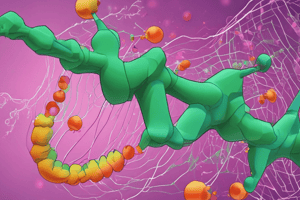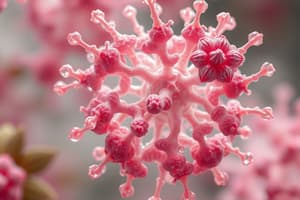Podcast
Questions and Answers
What is the main difference between saturated and unsaturated fatty acids?
What is the main difference between saturated and unsaturated fatty acids?
- Presence of carbon atoms
- Number of hydroxyl groups
- Source of fatty acids
- Type of carbon-carbon bond (correct)
What is the result of hydrogenation of an unsaturated fatty acid?
What is the result of hydrogenation of an unsaturated fatty acid?
- Increase in unsaturation
- Change in melting point
- Decrease in unsaturation (correct)
- Change in physical state
What is the main characteristic of polyunsaturated fatty acids?
What is the main characteristic of polyunsaturated fatty acids?
- Equal number of double and single bonds per fatty acid chain
- No double bonds per fatty acid chain
- More than one double bond per fatty acid chain (correct)
- Only one double bond per fatty acid chain
What is the function of oleate proteins?
What is the function of oleate proteins?
What is the purpose of saponification?
What is the purpose of saponification?
What is the main characteristic of glycerophospholipids in membrane structure?
What is the main characteristic of glycerophospholipids in membrane structure?
What is the meaning of the Greek word 'lipos' from which the term 'lipid' is derived?
What is the meaning of the Greek word 'lipos' from which the term 'lipid' is derived?
What is the energy density of lipids compared to carbohydrates?
What is the energy density of lipids compared to carbohydrates?
What is the main function of lipids as a storage form of energy?
What is the main function of lipids as a storage form of energy?
What is the result of hydrolysis of lipids?
What is the result of hydrolysis of lipids?
What is the structure of triglycerides?
What is the structure of triglycerides?
What is the range of carbon atoms in fatty acids?
What is the range of carbon atoms in fatty acids?
Flashcards
Saturated Fatty Acids
Saturated Fatty Acids
Fatty acids with only single carbon-carbon bonds.
Unsaturated Fatty Acids
Unsaturated Fatty Acids
Fatty acids containing one or more carbon-carbon double bonds.
Trans Fats
Trans Fats
Fats created by partial hydrogenation of oil, existing in solid form.
Triglycerides
Triglycerides
Signup and view all the flashcards
Essential Fatty Acids
Essential Fatty Acids
Signup and view all the flashcards
Hydrogenation
Hydrogenation
Signup and view all the flashcards
Saponification
Saponification
Signup and view all the flashcards
Phospholipids
Phospholipids
Signup and view all the flashcards
Glycolipids
Glycolipids
Signup and view all the flashcards
Membrane Lipids
Membrane Lipids
Signup and view all the flashcards
Lipids
Lipids
Signup and view all the flashcards
Lipid Functions
Lipid Functions
Signup and view all the flashcards
Study Notes
Fatty Acids
- Saturated Fatty Acids have a single carbon-carbon bond.
- Unsaturated Fatty Acids have one to several double bonds.
- Trans Fats are solid forms of fat, created through partial hydrogenation of oil.
Triglycerides
- Also known as tricylglycerols, where three hydroxyl groups of glycerol are esterified with fatty acids.
- Properties: Physical State, Solid animal fats contain mainly saturated fatty acids, while Vegetable oils contain high amounts of unsaturated fatty acids.
- Some unsaturated fatty acids (linoleic and linolenic acids) are essential fatty acids.
- Oils with an average of more than one double bond per fatty acid chain are called polyunsaturated.
- Melting points of fatty acids increase as the number of carbons in the hydrocarbon chains increases and as the number of double bonds decreases.
- Triglycerides rich in unsaturated fatty acids are generally liquid at room temperature and are called oils.
- Triglycerides rich in saturated fatty acids are generally semi-solids or solids at room temperature and are called fats.
Hydrogenation and Saponification
- Hydrogenation is the source of trans fatty acids, adding hydrogen across the carbon-to-carbon double bond in an unsaturated fatty acid.
- Saponification is the base-promoted hydrolysis of fats and oils in aqueous NaOH, producing glycerol and a mixture of fatty acid salts called soaps.
Complex Lipids
- Phospholipids contain an alcohol, two fatty acids, and a phosphate ester.
- Glycerophospholipids have glycerol as the alcohol, while sphingolipids have sphingosine.
- Glycolipids contain a carbohydrate, or sugar, residue.
Role of Lipids in Membrane Structure
- Polar (hydrophilic) head groups are in contact with the aqueous environment.
- Nonpolar (hydrophobic) tails are buried within the bilayer and shielded from the aqueous environment.
- Glycerophospholipids, also called phosphoglycerides, are the second most abundant group of naturally occurring lipids.
Lipids
- Insoluble in water, soluble in non-polar solvents and solvents of low polarity.
- Derived from the Greek word 'lipos', meaning fat.
- Have higher energy density than carbohydrates.
- Heterogeneous group of compounds related to fatty acids, fats, oils, waxes, and other related substances.
- Yield fatty acids upon hydrolysis, which are utilized by living organisms.
Classification of Lipids
- By function: Storage, Membrane Components, Messengers
- By type: Simple Fats and Oils (Triacylglycerols), Waxes, Fats, Oils, Complex Phospholipids, Glycolipids, Lipoproteins, Other Complex Lipids (Steroids, hormones derived from cholesterol)
Studying That Suits You
Use AI to generate personalized quizzes and flashcards to suit your learning preferences.




